人教版(2019)选择性必修第一册Unit 4 Body Language Reading and Thinking 复习课件(共29张PPT)
文档属性
| 名称 | 人教版(2019)选择性必修第一册Unit 4 Body Language Reading and Thinking 复习课件(共29张PPT) | 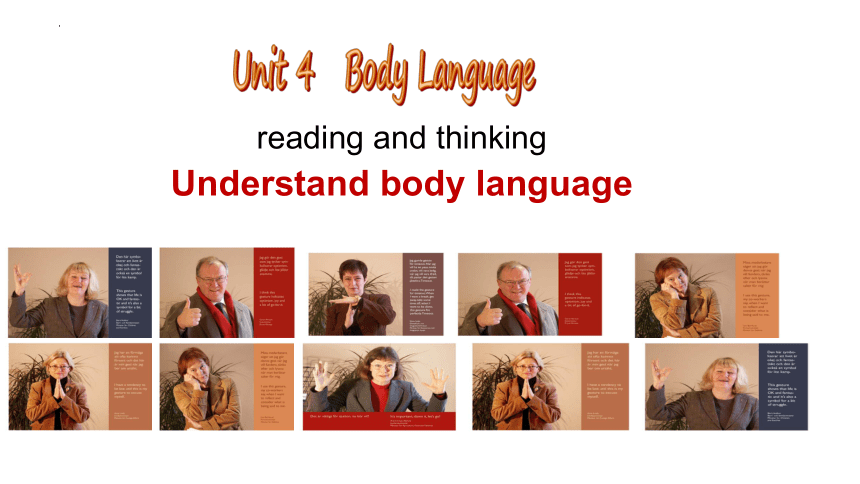 | |
| 格式 | pptx | ||
| 文件大小 | 3.2MB | ||
| 资源类型 | 教案 | ||
| 版本资源 | 人教版(2019) | ||
| 科目 | 英语 | ||
| 更新时间 | 2024-05-20 18:08:56 | ||
图片预览

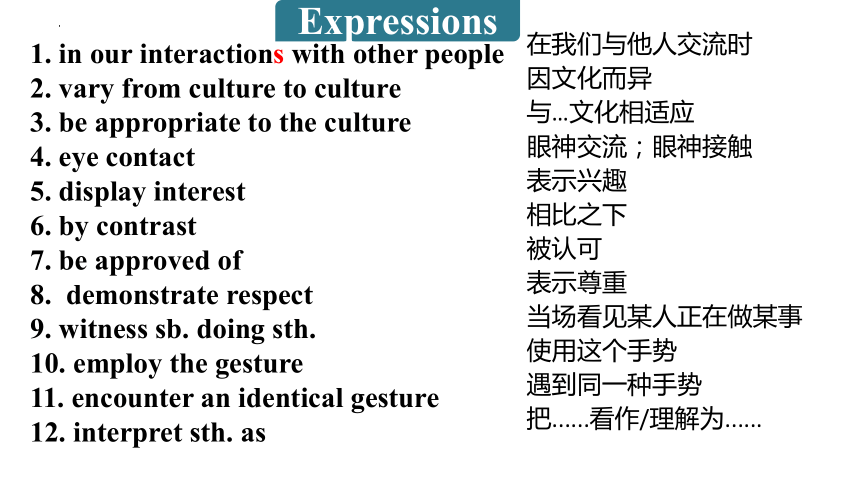
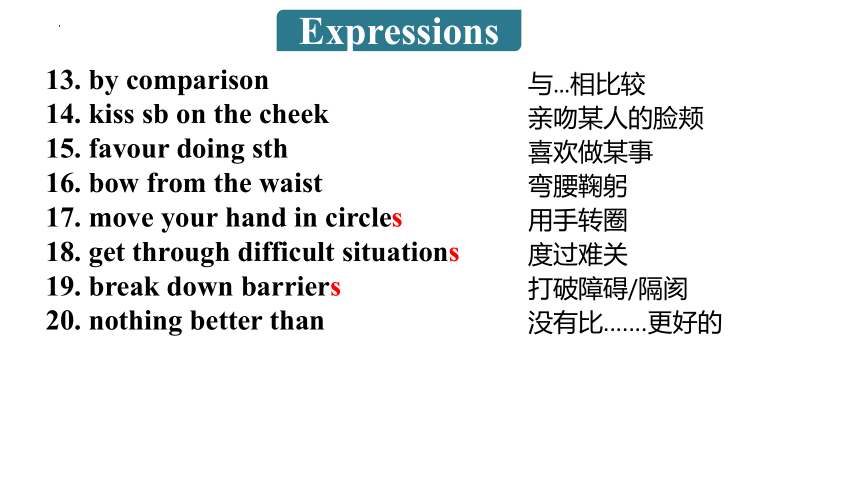


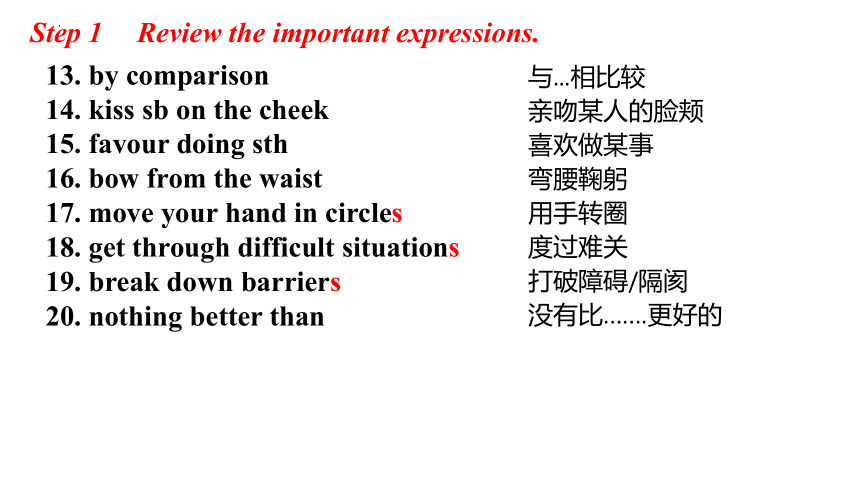
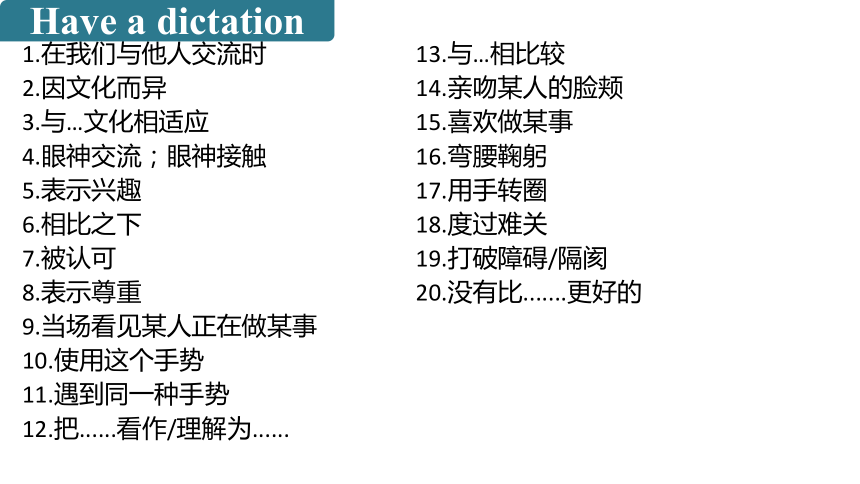
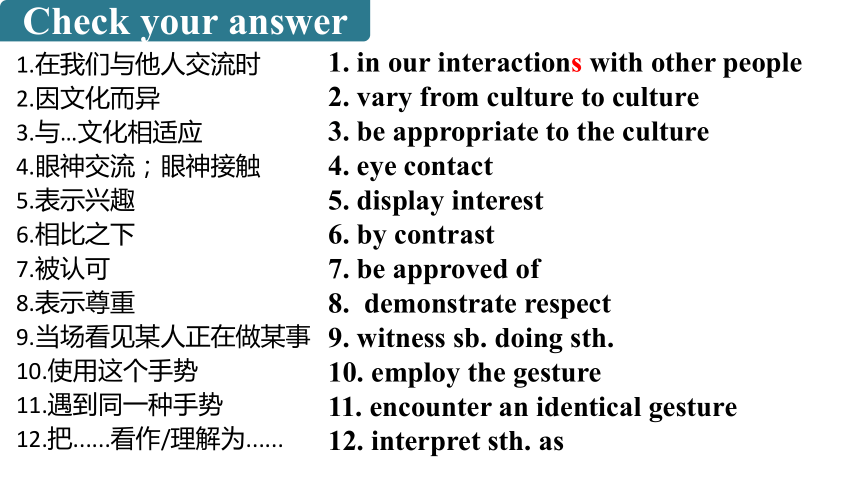
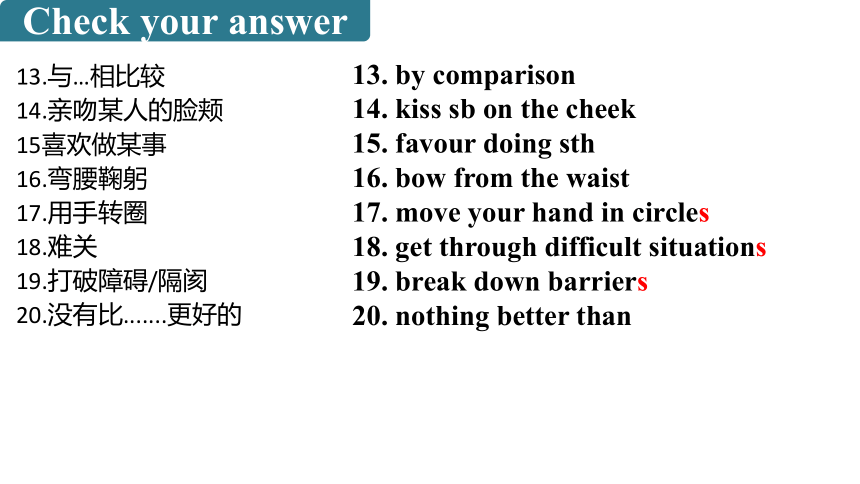
文档简介
(共29张PPT)
Unit 4 Body Language
reading and thinking
Understand body language
1. in our interactions with other people
2. vary from culture to culture
3. be appropriate to the culture
4. eye contact
5. display interest
6. by contrast
7. be approved of
8. demonstrate respect
9. witness sb. doing sth.
10. employ the gesture
11. encounter an identical gesture
12. interpret sth. as
在我们与他人交流时
因文化而异
与…文化相适应
眼神交流;眼神接触
表示兴趣
相比之下
被认可
表示尊重
当场看见某人正在做某事
使用这个手势
遇到同一种手势
把......看作/理解为......
Expressions
13. by comparison
14. kiss sb on the cheek
15. favour doing sth
16. bow from the waist
17. move your hand in circles
18. get through difficult situations
19. break down barriers
20. nothing better than
与…相比较
亲吻某人的脸颊
喜欢做某事
弯腰鞠躬
用手转圈
度过难关
打破障碍/隔阂
没有比.......更好的
Expressions
Learning objectives
To remember some important phrases.
To analyse difficult and important sentences properly.
To review the passage and fill in the blanks .
To write a passage about Chinese body language.
1. in our interactions with other people
2. vary from culture to culture
3. be appropriate to the culture
4. eye contact
5. display interest
6. by contrast
7. be approved of
8. demonstrate respect
9. witness sb. doing sth.
10. employ the gesture
11. encounter an identical gesture
12. interpret sth. as
在我们与他人交流时
因文化而异
与…文化相适应
眼神交流;眼神接触
表示兴趣
相比之下
被认可
表示尊重
当场看见某人正在做某事
使用这个手势
遇到同一种手势
把......看作/理解为......
Step1 Review the important expressions.
13. by comparison
14. kiss sb on the cheek
15. favour doing sth
16. bow from the waist
17. move your hand in circles
18. get through difficult situations
19. break down barriers
20. nothing better than
与…相比较
亲吻某人的脸颊
喜欢做某事
弯腰鞠躬
用手转圈
度过难关
打破障碍/隔阂
没有比.......更好的
Step 1 Review the important expressions.
1.在我们与他人交流时
2.因文化而异
3.与…文化相适应
4.眼神交流;眼神接触
5.表示兴趣
6.相比之下
7.被认可
8.表示尊重
9.当场看见某人正在做某事
10.使用这个手势
11.遇到同一种手势
12.把......看作/理解为......
13.与…相比较
14.亲吻某人的脸颊
15.喜欢做某事
16.弯腰鞠躬
17.用手转圈
18.度过难关
19.打破障碍/隔阂
20.没有比.......更好的
Have a dictation
Check your answer
1.在我们与他人交流时
2.因文化而异
3.与…文化相适应
4.眼神交流;眼神接触
5.表示兴趣
6.相比之下
7.被认可
8.表示尊重
9.当场看见某人正在做某事
10.使用这个手势
11.遇到同一种手势
12.把......看作/理解为......
1. in our interactions with other people
2. vary from culture to culture
3. be appropriate to the culture
4. eye contact
5. display interest
6. by contrast
7. be approved of
8. demonstrate respect
9. witness sb. doing sth.
10. employ the gesture
11. encounter an identical gesture
12. interpret sth. as
13.与…相比较
14.亲吻某人的脸颊
15喜欢做某事
16.弯腰鞠躬
17.用手转圈
18.难关
19.打破障碍/隔阂
20.没有比.......更好的
13. by comparison
14. kiss sb on the cheek
15. favour doing sth
16. bow from the waist
17. move your hand in circles
18. get through difficult situations
19. break down barriers
20. nothing better than
Check your answer
1. Words are important, but the way people stand, hold their arms, and
move their hands can also give us information about their feelings.
(P38) 话语十分重要,但是人们站立、双手抱臂和移动双手的姿势,
也能为我们提供有关他们情感的信息。
2. The crucial thing is using body language in a way that is appropriate
to the culture you are in. (P38)
使用肢体语言时,最重要的是要符合你所处的文化。
句1中,the way作先行词,people stand ...是__________;
句2中,a way 作先行词,that is ...是__________。
两个从句的引导词一样吗?
句1中省略的引导词是___________________在从句中作方式状语,
句2中的引导词是______________在从句中作主语。
定语从句
定语从句
that / in which
Observe and Find
Step 2 Important sentences (P38 ~ P40)
that / which
(1) I don’t like the way ___________________ he speaks to me.
(2) He has given you the way _____________ is best to solve the
problem.
that / in which / 省略
that / which
即学即练
方式状语
主语
Step 2 Important sentences (P38 ~ P40)
3.We can learn a lot about what people are thinking by① watching
their body language. (P38)
4.In France, a person encountering an identical gesture may interpret it
as ② meaning zero. (P38)
5. However, you should avoid ③ making this gesture in Brazil and
Germany, as it is not considered polite. (P38)
6.Elsewhere, people favour④ shaking hands, bowing from the waist, or nodding the head when they meet someone else.
7. Experts suggest ⑤smiling at yourself in the mirror to make yourself feel happier and stronger.
现在分词短语①②在句中分别作介词by和as的______;
现在分词短语③④⑤在句中分别作动词avoid,favour和suggest的____
宾语
宾语
Step 3 Important sentences (P38 ~ P40)
8. The crucial thing is① using body language in a way that is appropriate to the culture you are in. (P38)
9. A good way of saying "I am full" is ②moving your hand in circles over your stomach after a meal.
10. Perhaps the best example is smiling.
现在分词短语①②③在句中作系动词be的_______
Observe and Find
表语
Step 3 Important sentences (P38 ~ P40)
11. For example, ①making eye contact—looking into someone’s eyes—in some countries is a way to display interest.
12.In many countries, ②shaking one’s head means “no”, and ②nodding means “yes”.
13.③Placing your hands together and resting them on the side of your head while closing your eyes means “sleep”.
现在分词短语①②③在句中作_______,谓语动词用的_______。
句3中有两个并列的现在分词短语作主语,表示连续的一件事,谓语动词也是用的_______。
Observe and Find
主语
单数
单数
Step 3 Important sentences (P38 ~ P40)
14. In France, a person ①encountering an identical gesture may interpret it as meaning zero.
=In France, a person _______ encounters an identical gesture may interpret it as meaning zero.
现在分词短语①在句中作____________,可以转换为定语从句。
Observe and Find
后置定语
that/who
Step 3 Important sentences (P38 ~ P40)
1.关键是使用身势语的方式要与你所处的文化相适应。
The crucial thing is using body language in a way that is appropriate to the culture you are in.
2.例如,在有些国家,眼神交流—看着别人的眼睛—是表现兴趣的一种方式。
For example, making eye contact—looking into someone’s eyes—in some countries is a way to display interest.
3.在法国,看到同一个手势的人可能会将其解读为“零”。
In France, a person encountering an identical gesture may interpret it as meaning zero.
4.专家建议对着镜子微笑来让自己更快乐、更坚强。
Experts suggest smiling at yourself in the mirror to make yourself feel happier and stronger.
5.而且如果我们感到沮丧或孤独,没有什么比看到好朋友的笑脸更好的了。
And if we are feeling down or lonely, there is nothing better than seeing the smiling face of a good friend.
Remember the Important sentences (P38 ~ P40)
1.关键是使用身势语的方式要与你所处的文化相适应。
The crucial thing is using body language in a way that is appropriate to the culture you are in.
2.例如,在有些国家,眼神交流—看着别人的眼睛—是表现兴趣的一种方式。
For example, making eye contact—looking into someone’s eyes—in some countries is a way to display interest.
3.在法国,看到同一个手势的人可能会将其解读为“零”。
In France, a person encountering an identical gesture may interpret it as meaning zero.
4.专家建议对着镜子微笑来让自己更快乐、更坚强。
Experts suggest smiling at yourself in the mirror to make yourself feel happier and stronger.
5.而且如果我们感到沮丧或孤独,没有什么比看到好朋友的笑脸更好的了。
And if we are feeling down or lonely, there is nothing better than seeing the smiling face of a good friend.
Remember the Important sentences (P38 ~ P40)
Step 3 Review the passage and fill in the blanks with the expressions.
LISTENING TO HOW BODIES TALK
The general introduction Both words and body language are used to 1. thoughts and opinions. We can learn a lot about others’ thoughts by watching 2. .
The body language in different cultures Body language 3. from culture to culture. The crucial thing is using body language in a way that is
4. to the culture you are in.
express
their body language
varies
appropriate
The gesture for “OK” It has different meanings in different cultures. In Japan it means 5. . In France, it means zero. However, it is not considered
6. in Brazil and Germany.
The gestures for “yes” and “no” In general, shaking one’s head means “no”, and nodding means “yes”. But in Bulgaria and southern Albania, they have the
7. .
The gestures with the same meaning Placing your hands together and resting them on the side of your head while closing your eyes means “sleep”. Moving your hand
8. over your stomach after a meal means “I am full”.
The body language with different uses A smile can help us 9. difficult situations, find friends in a world of strangers, and 10._____________ barriers. We can use a smile to apologise, to greet someone, to ask for help, or to start a conversation.
money
polite
opposite meaning
in circles
get through
break down
Step 3 Review the passage and fill in the blanks with the expressions.
Part 1 (Para1)
Introduction to body language
Part 2 (Para2-4)
Part 3 (Para 5)
Part 4 (Para 6)
总
|
分
The differences
The similarities
Different uses
Step 3 Revise the structure of the passage
What advice on body language
can you give a foreign friend
on his/her first trip to China
Step 4 Group Discussion
In China,when people meet for the first time, it is proper for us to ______________________________ rather than__________________, and keep _________________.
shake hands with others and smile
kiss on the hand
a proper distance
Advice on body language in China
Step 4 Group Discussion
In China, it’s good manners to _____________ and have ___________ when talking to others.
keep smiling
eye contact
Advice on body language in China
Step 4 Group Discussion
In China,when we sit or stand, we’d better not __________________ or ______________________ .
sit with crossed legs
stand with crossed arms
Advice on body language in China
Step 4 Group Discussion
What advice on body language can you give a foreign friend on his/her first trip on China
When ..., Chinese people prefer to ..., because...
In China, it’s a good manner to...
In China,when we ..., it isn’t appropriate(合适的) to ...
Step 5 Writing
假如你是李华,你的英国朋友Robert准备来中国学习,因此想了解一些中国人的肢体语言。请你用英语给他写封邮件,向他介绍一些日常的肢体语言。
Dear Robert,
I am glad to receive your email. Now I will tell you something about body language in China.
__________________________________________
__________________________________________
__________________________________________
Yours,
Li Hua
Step 5 Writing
Homework
1.Finish the writing after class.
2.Share the writing with your classmates and friends.
Thank you!
Unit 4 Body Language
reading and thinking
Understand body language
1. in our interactions with other people
2. vary from culture to culture
3. be appropriate to the culture
4. eye contact
5. display interest
6. by contrast
7. be approved of
8. demonstrate respect
9. witness sb. doing sth.
10. employ the gesture
11. encounter an identical gesture
12. interpret sth. as
在我们与他人交流时
因文化而异
与…文化相适应
眼神交流;眼神接触
表示兴趣
相比之下
被认可
表示尊重
当场看见某人正在做某事
使用这个手势
遇到同一种手势
把......看作/理解为......
Expressions
13. by comparison
14. kiss sb on the cheek
15. favour doing sth
16. bow from the waist
17. move your hand in circles
18. get through difficult situations
19. break down barriers
20. nothing better than
与…相比较
亲吻某人的脸颊
喜欢做某事
弯腰鞠躬
用手转圈
度过难关
打破障碍/隔阂
没有比.......更好的
Expressions
Learning objectives
To remember some important phrases.
To analyse difficult and important sentences properly.
To review the passage and fill in the blanks .
To write a passage about Chinese body language.
1. in our interactions with other people
2. vary from culture to culture
3. be appropriate to the culture
4. eye contact
5. display interest
6. by contrast
7. be approved of
8. demonstrate respect
9. witness sb. doing sth.
10. employ the gesture
11. encounter an identical gesture
12. interpret sth. as
在我们与他人交流时
因文化而异
与…文化相适应
眼神交流;眼神接触
表示兴趣
相比之下
被认可
表示尊重
当场看见某人正在做某事
使用这个手势
遇到同一种手势
把......看作/理解为......
Step1 Review the important expressions.
13. by comparison
14. kiss sb on the cheek
15. favour doing sth
16. bow from the waist
17. move your hand in circles
18. get through difficult situations
19. break down barriers
20. nothing better than
与…相比较
亲吻某人的脸颊
喜欢做某事
弯腰鞠躬
用手转圈
度过难关
打破障碍/隔阂
没有比.......更好的
Step 1 Review the important expressions.
1.在我们与他人交流时
2.因文化而异
3.与…文化相适应
4.眼神交流;眼神接触
5.表示兴趣
6.相比之下
7.被认可
8.表示尊重
9.当场看见某人正在做某事
10.使用这个手势
11.遇到同一种手势
12.把......看作/理解为......
13.与…相比较
14.亲吻某人的脸颊
15.喜欢做某事
16.弯腰鞠躬
17.用手转圈
18.度过难关
19.打破障碍/隔阂
20.没有比.......更好的
Have a dictation
Check your answer
1.在我们与他人交流时
2.因文化而异
3.与…文化相适应
4.眼神交流;眼神接触
5.表示兴趣
6.相比之下
7.被认可
8.表示尊重
9.当场看见某人正在做某事
10.使用这个手势
11.遇到同一种手势
12.把......看作/理解为......
1. in our interactions with other people
2. vary from culture to culture
3. be appropriate to the culture
4. eye contact
5. display interest
6. by contrast
7. be approved of
8. demonstrate respect
9. witness sb. doing sth.
10. employ the gesture
11. encounter an identical gesture
12. interpret sth. as
13.与…相比较
14.亲吻某人的脸颊
15喜欢做某事
16.弯腰鞠躬
17.用手转圈
18.难关
19.打破障碍/隔阂
20.没有比.......更好的
13. by comparison
14. kiss sb on the cheek
15. favour doing sth
16. bow from the waist
17. move your hand in circles
18. get through difficult situations
19. break down barriers
20. nothing better than
Check your answer
1. Words are important, but the way people stand, hold their arms, and
move their hands can also give us information about their feelings.
(P38) 话语十分重要,但是人们站立、双手抱臂和移动双手的姿势,
也能为我们提供有关他们情感的信息。
2. The crucial thing is using body language in a way that is appropriate
to the culture you are in. (P38)
使用肢体语言时,最重要的是要符合你所处的文化。
句1中,the way作先行词,people stand ...是__________;
句2中,a way 作先行词,that is ...是__________。
两个从句的引导词一样吗?
句1中省略的引导词是___________________在从句中作方式状语,
句2中的引导词是______________在从句中作主语。
定语从句
定语从句
that / in which
Observe and Find
Step 2 Important sentences (P38 ~ P40)
that / which
(1) I don’t like the way ___________________ he speaks to me.
(2) He has given you the way _____________ is best to solve the
problem.
that / in which / 省略
that / which
即学即练
方式状语
主语
Step 2 Important sentences (P38 ~ P40)
3.We can learn a lot about what people are thinking by① watching
their body language. (P38)
4.In France, a person encountering an identical gesture may interpret it
as ② meaning zero. (P38)
5. However, you should avoid ③ making this gesture in Brazil and
Germany, as it is not considered polite. (P38)
6.Elsewhere, people favour④ shaking hands, bowing from the waist, or nodding the head when they meet someone else.
7. Experts suggest ⑤smiling at yourself in the mirror to make yourself feel happier and stronger.
现在分词短语①②在句中分别作介词by和as的______;
现在分词短语③④⑤在句中分别作动词avoid,favour和suggest的____
宾语
宾语
Step 3 Important sentences (P38 ~ P40)
8. The crucial thing is① using body language in a way that is appropriate to the culture you are in. (P38)
9. A good way of saying "I am full" is ②moving your hand in circles over your stomach after a meal.
10. Perhaps the best example is smiling.
现在分词短语①②③在句中作系动词be的_______
Observe and Find
表语
Step 3 Important sentences (P38 ~ P40)
11. For example, ①making eye contact—looking into someone’s eyes—in some countries is a way to display interest.
12.In many countries, ②shaking one’s head means “no”, and ②nodding means “yes”.
13.③Placing your hands together and resting them on the side of your head while closing your eyes means “sleep”.
现在分词短语①②③在句中作_______,谓语动词用的_______。
句3中有两个并列的现在分词短语作主语,表示连续的一件事,谓语动词也是用的_______。
Observe and Find
主语
单数
单数
Step 3 Important sentences (P38 ~ P40)
14. In France, a person ①encountering an identical gesture may interpret it as meaning zero.
=In France, a person _______ encounters an identical gesture may interpret it as meaning zero.
现在分词短语①在句中作____________,可以转换为定语从句。
Observe and Find
后置定语
that/who
Step 3 Important sentences (P38 ~ P40)
1.关键是使用身势语的方式要与你所处的文化相适应。
The crucial thing is using body language in a way that is appropriate to the culture you are in.
2.例如,在有些国家,眼神交流—看着别人的眼睛—是表现兴趣的一种方式。
For example, making eye contact—looking into someone’s eyes—in some countries is a way to display interest.
3.在法国,看到同一个手势的人可能会将其解读为“零”。
In France, a person encountering an identical gesture may interpret it as meaning zero.
4.专家建议对着镜子微笑来让自己更快乐、更坚强。
Experts suggest smiling at yourself in the mirror to make yourself feel happier and stronger.
5.而且如果我们感到沮丧或孤独,没有什么比看到好朋友的笑脸更好的了。
And if we are feeling down or lonely, there is nothing better than seeing the smiling face of a good friend.
Remember the Important sentences (P38 ~ P40)
1.关键是使用身势语的方式要与你所处的文化相适应。
The crucial thing is using body language in a way that is appropriate to the culture you are in.
2.例如,在有些国家,眼神交流—看着别人的眼睛—是表现兴趣的一种方式。
For example, making eye contact—looking into someone’s eyes—in some countries is a way to display interest.
3.在法国,看到同一个手势的人可能会将其解读为“零”。
In France, a person encountering an identical gesture may interpret it as meaning zero.
4.专家建议对着镜子微笑来让自己更快乐、更坚强。
Experts suggest smiling at yourself in the mirror to make yourself feel happier and stronger.
5.而且如果我们感到沮丧或孤独,没有什么比看到好朋友的笑脸更好的了。
And if we are feeling down or lonely, there is nothing better than seeing the smiling face of a good friend.
Remember the Important sentences (P38 ~ P40)
Step 3 Review the passage and fill in the blanks with the expressions.
LISTENING TO HOW BODIES TALK
The general introduction Both words and body language are used to 1. thoughts and opinions. We can learn a lot about others’ thoughts by watching 2. .
The body language in different cultures Body language 3. from culture to culture. The crucial thing is using body language in a way that is
4. to the culture you are in.
express
their body language
varies
appropriate
The gesture for “OK” It has different meanings in different cultures. In Japan it means 5. . In France, it means zero. However, it is not considered
6. in Brazil and Germany.
The gestures for “yes” and “no” In general, shaking one’s head means “no”, and nodding means “yes”. But in Bulgaria and southern Albania, they have the
7. .
The gestures with the same meaning Placing your hands together and resting them on the side of your head while closing your eyes means “sleep”. Moving your hand
8. over your stomach after a meal means “I am full”.
The body language with different uses A smile can help us 9. difficult situations, find friends in a world of strangers, and 10._____________ barriers. We can use a smile to apologise, to greet someone, to ask for help, or to start a conversation.
money
polite
opposite meaning
in circles
get through
break down
Step 3 Review the passage and fill in the blanks with the expressions.
Part 1 (Para1)
Introduction to body language
Part 2 (Para2-4)
Part 3 (Para 5)
Part 4 (Para 6)
总
|
分
The differences
The similarities
Different uses
Step 3 Revise the structure of the passage
What advice on body language
can you give a foreign friend
on his/her first trip to China
Step 4 Group Discussion
In China,when people meet for the first time, it is proper for us to ______________________________ rather than__________________, and keep _________________.
shake hands with others and smile
kiss on the hand
a proper distance
Advice on body language in China
Step 4 Group Discussion
In China, it’s good manners to _____________ and have ___________ when talking to others.
keep smiling
eye contact
Advice on body language in China
Step 4 Group Discussion
In China,when we sit or stand, we’d better not __________________ or ______________________ .
sit with crossed legs
stand with crossed arms
Advice on body language in China
Step 4 Group Discussion
What advice on body language can you give a foreign friend on his/her first trip on China
When ..., Chinese people prefer to ..., because...
In China, it’s a good manner to...
In China,when we ..., it isn’t appropriate(合适的) to ...
Step 5 Writing
假如你是李华,你的英国朋友Robert准备来中国学习,因此想了解一些中国人的肢体语言。请你用英语给他写封邮件,向他介绍一些日常的肢体语言。
Dear Robert,
I am glad to receive your email. Now I will tell you something about body language in China.
__________________________________________
__________________________________________
__________________________________________
Yours,
Li Hua
Step 5 Writing
Homework
1.Finish the writing after class.
2.Share the writing with your classmates and friends.
Thank you!
